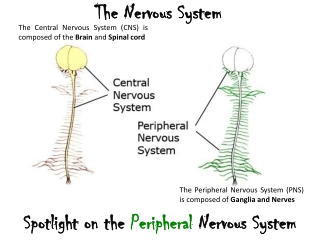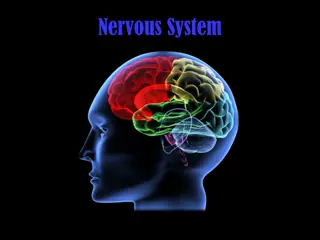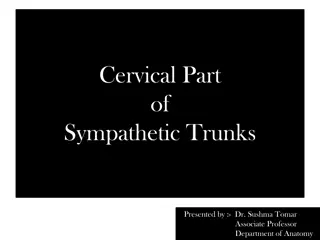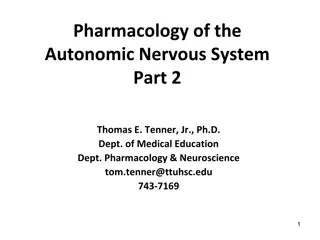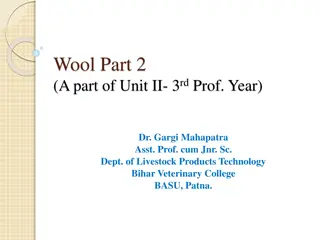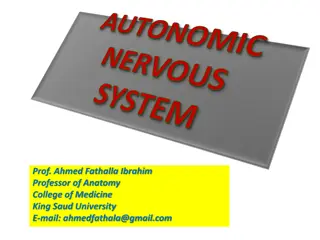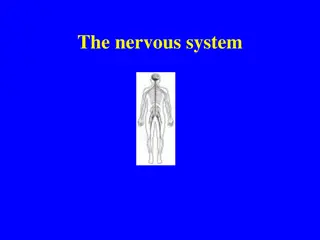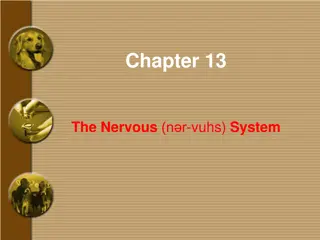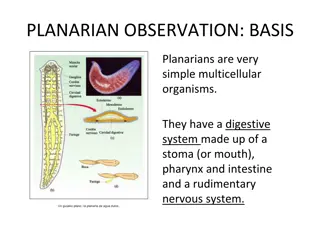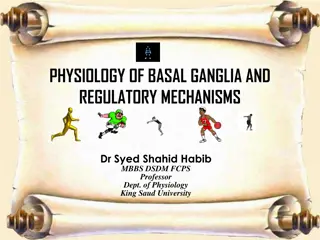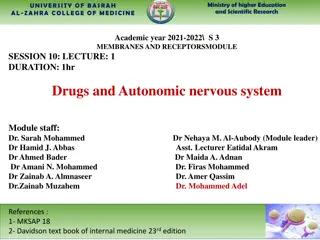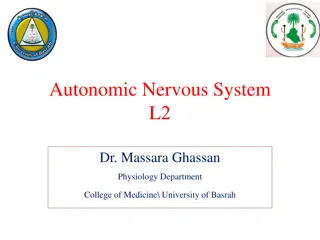Understanding the Role of Basal Ganglia in the Autonomic Nervous System
Basal ganglia, located in the cerebrum, play a crucial role in motor control and regulatory mechanisms. This lecture covers the physiology of basal ganglia, including different nuclei and neurotransmitters involved, their general functions, and diagnosing associated disorders. The component anatomy, connections, and overall function of basal ganglia are explored, highlighting their significance in motor activity control and sensory input processing.
Download Presentation

Please find below an Image/Link to download the presentation.
The content on the website is provided AS IS for your information and personal use only. It may not be sold, licensed, or shared on other websites without obtaining consent from the author. Download presentation by click this link. If you encounter any issues during the download, it is possible that the publisher has removed the file from their server.
E N D
Presentation Transcript
BASAL GANGLIA The Autonomic Nervous System Fawzia Al-Rouq Department of Physiology College of Medicine King Saud University
Objectives Physiology of basal ganglia and regulatory mechanisms At the end of this lectutre the student should be able to:- 1-appreciate different nuclei of basal ganglia 2-know different neurotransmitters that have a role in basal ganglia functions 3-appreciate general functions of basal ganglia 4-diagnose basal ganglia disorders 3
BASAL GANGLIA Basal ganglia are subcorticle nuclei of grey matter located in the interior part of cerebrum near about base 5
OVERVIEW OF MOTOR ACTIVITY CONTROL
Cerebral Cortex CEREBRAL CORTEX Cerebral Cortex BASAL GANGLIA Corticospinal tracts THALAMIUS Corticobulbar tracts CEREBELLUM BRAIN STEM Bulbospinal tracts SENSORY INPUT SPINAL CORD FINAL COMMON PATH
BASAL GANGLIA COMPONENTS FUNCTIONAL ANATOMY
Basal Nuclei Caudate Nucleus Corpus Striatum Putamen Lenticular Nucleus Globus Pallidus Subthalamic Nucleus Substantia Nigra
BASAL GANGLIA CONNECTIONS
Connections for Motor Control
3 Connections to remember 1. Main input to the basal ganglia 2. Main output from the basal ganglia 3. Connections between parts of basal ganglia Basal Nuclei Caudate Nucleus Corpus Striatum Putamen Lentiform Globus Pallidus Subthalamic Nucleus Substantia Nigra
MAIN INPUT TO THE BASAL GANGLIA The comes from the cerebral cortex (motor area) and projects to the NEOSTRIATUM (a term for the caudate nucleus and putamen) THE MAIN OUTPUT Is via the thalamus to the cerebral cortex (motor area)
BASIC CIRCUITS OF BASAL GANGLIA 1. Motor loop (putamen circuit) concerned with learned movment. 2. Cognitive loop (Caudate circuit) concerned with cognitive control of sequences of motor pattern. Basically it is concerned with motor intentions. (Note: cognition means thinking process using sensory input with information already stored in memory.) 3. Limbic loop involved in giving motor expression to emotions like, smiling, aggressive or submissive posture. 4. Occulomotor loop concerned with voluntary eye movement [ saccadic movement] 14
The Putamen Circuit Prim Motor Cortex Premotor Suppl Motor Areas Premotor Suppl Motor Somatosensory Cortex
The Caudate Circuit Prefrontal Premotor Suppl Motor Association Areas
Basal Ganglial Pathways Direct and Indirect
MOTOR ACTIVITY Direct Basal Ganglial Pathway + GLU GLU + GPe + - DA1+ GABA St GPi - Thalamus GABA - DA2 - Thalamocortical Neurons are disinhibited SThN SNPC
MOTOR ACTIVITY Indirect Basal Ganglial Pathway + GLU + GLU GPe - GABA St GPi GABA - Thalamus - + DA1+ DA2 - GABA + GLU Subthalamic Neurons are disinhibited - SThN SNPC
MOTOR ACTIVITY Both Direct & Indirect Basal Ganglial Pathway MOTOR ACTIVITY Direct GPe Striatum GPi Thalamus SThN SNPC
MOTOR ACTIVITY Both Direct & Indirect Basal Ganglial Pathway MOTOR ACTIVITY + + GLU GLU GLU + - GABA GPe - GLU GABA + St GPi GABA - - Thalamus - GABA DA1 + + GLU DA2 - - GABA SThN SNPC
Metabolic characteristics High Oxygen consumption . High Copper content in Wilson s disease (Copper intoxication): Autosomal Recessive Copper binding protein Ceruloplasmin is low Lenticular degeneration occurs
BASAL GANGLIA FUNCTIONS Control of movements Planning and programming of movements Cognition
The Putamen Circuit Executes Learned Patterns of Motor Activity Basal ganglia function in association with the corticospinal system to control complex patterns of motor activity. Examples are: writing of letters of the alphabet. cutting paper with scissors, hammering nails, shooting a basketball through a hoop, passing a football, throwing a baseball, the movements of shoveling dirt, most aspects of vocalization, controlled movements of the eyes virtually any other of our skilled movements, most of them performed subconsciously.
The Caudate Circuit Cognitive Control of Sequences of Motor Patterns Cognition means the thinking processes of the brain, using both sensory input to the brain plus information already stored in memory. Thoughts are generated in the mind by a process called cognitive control of motor activity. Example:A person seeing a lion approach and then responding instantaneously and automatically by (1) turning away from the lion, (2) beginning to run, and (3) even attempting to climb a tree. Thus, cognitive control of motor activity determines subconsciously, and within seconds, which patterns of movement will be used together to achieve a complex goal
The Caudate Circuit Change the Timing and to Scale the Intensity of Movements Two important capabilities of the brain in controlling movement are (1) to determine how rapidly the movement is to be performed and (2) to control how large the movement will be. For instance, a person may write the letter "a" slowly or rapidly. Also, he or she may write a small "a" on a piece of paper or a large "a" on a chalkboard. Regardless of the choice, the proportional characteristics of the letter remain nearly the same
BASAL GANGLIA DISORDERS MOVEMENTS (ATAXIA Rate, Range, Force, Direction) SPEECH POSTURE GAIT MENTAL ACTIVITY OTHERS
Movement Disorders Hypokinetic Hyperkinetic Hemiballismus Huntington s Disease Athetosis Parkinson s Disease Drug Induced (Neuroleptics, MPTP)
Movement Disorder Chorea Features Lesion Multiole quick, random movements, usually most prominent in the appendicular muscles Slow writhing movements,which are usually more severe in the appendicular muscles Wild flinging movements of half of the body Atrophy of the striatum. Huntington Chorea Athetosis Diffuse hypermyelination of corpus striatum and thalamus Hemiballismus Hemorrhagic destruction of contralateral subthalamic n. Hypertensive patients Degenration of Substantia Nigra Parkinsonism Pill rolling tremor of the fingers at rest, lead pipe rigidity and akinesia
Parkinsons Disease Described by James Parkinson Degeneration of dopaminergic nigrostriatal neurons (60-80 %). Phenthiazines (tranquilizers drugs) . Methyl-Phenyl-Tetrahydro-Pyridine (MPTP). The oxidant MPP+ is toxic to SN. Five cardinal features Tremor Rigidity Akinesia & Bradykinesia Postural Changes Speech Changes evolution
Huntingtons Disease Hereditory , autosomal dominant . Disease of caudate & putamen. Jerky movement of hands toward end of reaching an object . Chorea Slurred speech and incomprehensive . Progressive Dementia - 32
Cont. Huntingtons Loss of GABA Cholinergic neurons . The loss of GABAergic neurons leads to chorea Loss of Dopaminergic neurons leads to Parkinson s disease . 33
Summary of functions of basal ganglia It play important motor function in starting and stopping motor functions and inhibiting unwanted movement. It changes the timing and scales the intensity of movements. Putamen circuit is inhibitory. Executes skilled motor activities for example cutting paper with a scissor, hammering on nail, shooting a basket ball & like throwing a base ball. Putamen circuit has indirect connection to cortex via thalamus.while caudate has direct conection to the cortex from thalamus. 34
Cont Caudate circuit is excitatory, has instinctive function which works without thinking and need quick response. eg. response after seeing a lion. [Note: effects of basal ganglia on motor activity are generally inhibitory.] Lesions of the basal ganglia produce effects on contra lateral side of the body Damage to basal ganglia does not cause paralysis. However it results in abnormal movements 35


